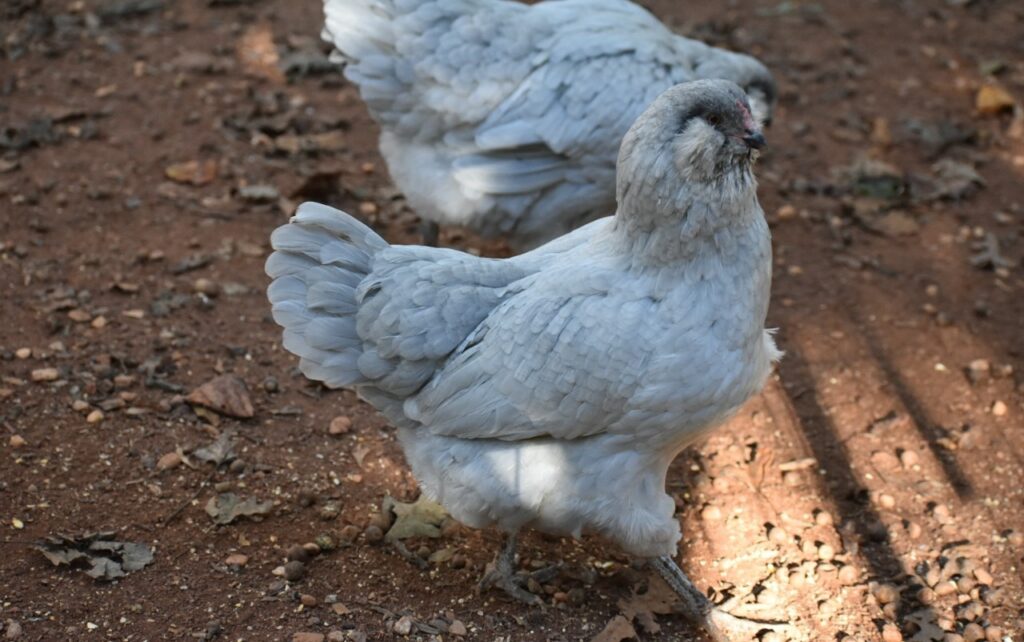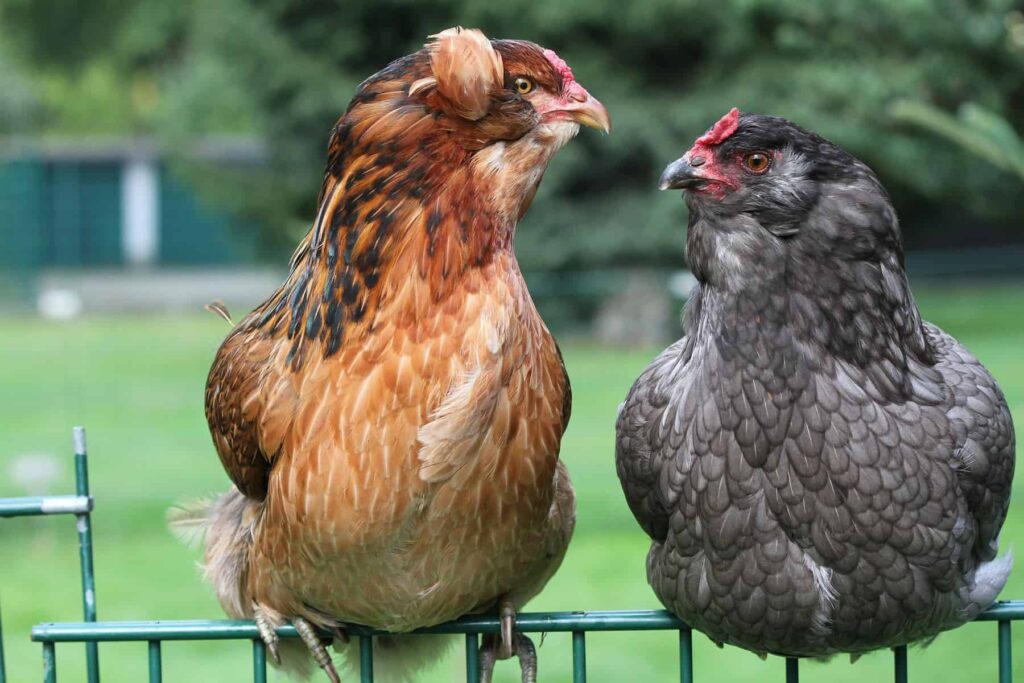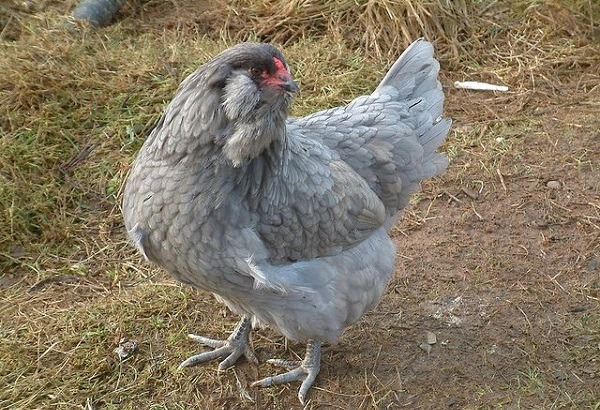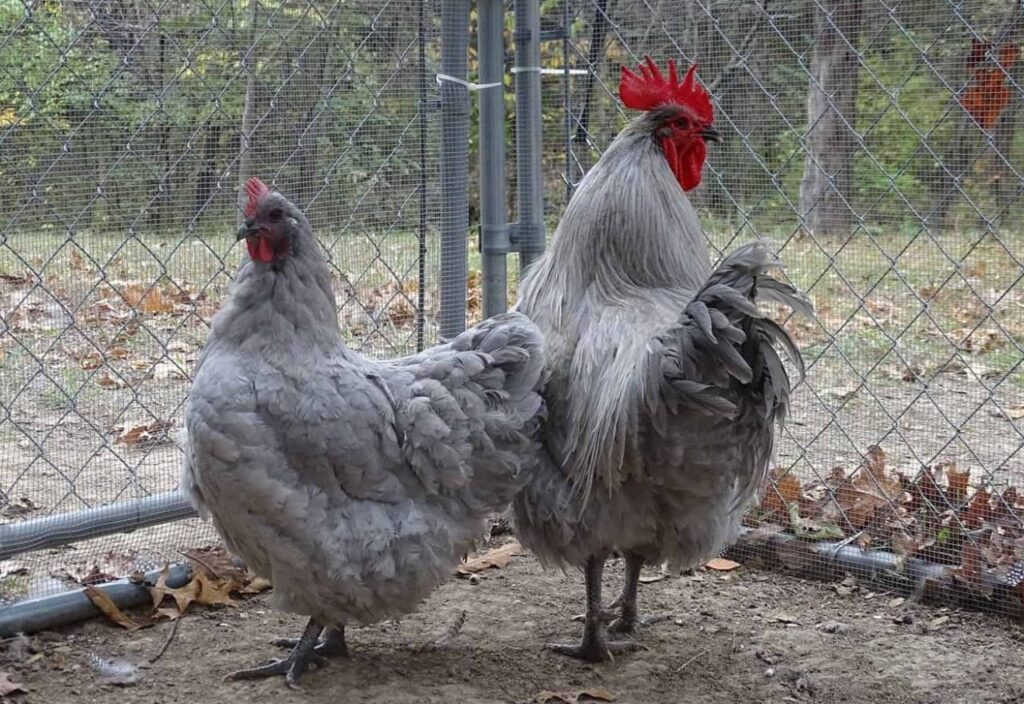
Are you looking for true blue eggs?
Are you looking for a bird that can give you true blue eggs? then Ameraucanas are the right bird for you.
Lavender Ameraucana is a relatively new species having the most beautiful shade of light grey feathers, with a hint of lavender. Although commonly known as lavender, the actual colour type according to SOP is Self Blue. Self-blue feathers are solid and should have no lace. The most desirable feature of this breed is ameraucana chicken egg color , which is blue in colour and medium-sized. Like all varieties of Ameraucanas, Self Blue will give you a basket of blue eggs. They are bred to retain the blue egg gene’s eggshell colour and have a quiet and calm personality. Self Blue and Blue Ameraucanas are two completely different colours, and for breeding purposes, should not be kept in the same pen. Self-Blue is a persistent trait, and when the Self is bred into Blue, it is born true. This means that lavender ameraucana hatching eggs will only provide blue babies themselves.
Lavender Ameraucana genetics and history:
You cannot fully understand Ameraucana without understanding its predecessor, Araucana. The blue egg of Ameraucanas comes from Araucana, the original rumpless, sometimes tufted, blue egg-laying species. At some point in his history, he contracted a harmless retrovirus that changed his genes, causing a pigment from the liver (biliverdin) to accumulate in the eggshell, giving it a blue colour. Gets a colour that we like a lot. It is very interesting how the genetics of egg colours work in chickens.

The blue dye permeates the shell so the Lavender Ameraucana eggs’ colour is blue inside and out. On the other hand, a brown egg comes from a pigment that is painted on the outside of the white egg. Both blue and brown egg genes are dominant so if a chick inherits copies of both, it will have a blue egg base with a brown one on top, resulting in a green egg.
Temperament:
Lavender Ameraucana chicks are best described as friendly and inquisitive. While they enjoy human interaction, you shouldn’t confuse them for lap chickens. They are generally docile and calm birds. Although they are not the most affectionate of all breeds, they are not flighty. It’s not out of the realm of possibility for a lavender ameraucana pullet to go broody. These gentle chickens are easily frightened even when they are not used to being around humans and may have small hearts. In general, they are very energetic birds and if given enough space to spread out, they get along very well with other birds of a similar size. They are very gentle loving chickens and have a good voices.
These gentle chickens are easily frightened even when they are not used to being around humans and have small hearts. In general, these are very energetic birds and if given enough space to spread out, they get along very well with other birds of a similar size. They are very gentle loving chickens and have a good voices.
Lavender ameraucana size:
A chicken’s weight is part of its classification. Ameraucanas are medium-sized chickens. A standard Ameraucana chicken can weigh 4.5 – 6.5 pounds and be 18 inches long. The Ameraucana is considered a light bird, however, larger birds can grow between 4.5 and 6.5 pounds, and should weigh around 6.5lb for males and 5.5lb for females, while Bantam versions weigh between 24 and 30 ounces. They can weigh anywhere from 24 to 30 ounces. 26-30 ounces for men and 24-26 ounces for women.
Ameraucana vs. Araucana:
A true Ameraucana is quite rare thanks to the common confusion between Ameraucanas, Araucanas and Easter Eggers. Ameraucana chickens should not be confused with Easter Eggers, as they are purebred and should not be confused with Araucanas, which are hairless and have tufts. True Ameraucanas always have a pea comb, lay blue eggs and come in a variety of colours. The Araucana is unruffled and has ear flaps. And the Ameraucana has a chicken tail and a beard. Lavender Ameraucana have been accepted into the APA in 1984 and created as a variety of Ameraucana in the 1970s to overcome a genetic problem with facial tufting, but with blue colouration, eggs can be preserved.

Araucana may have facial tufts or feather patches on each cheek. It is very different from the fluffy muffs of Ameraucana. If a chick gets two copies of the tufting gene, about 50% of the chicks will die in the shell. Although the tufts are quite remarkable in appearance, it is the problem of chicken mortality that breeders set out to solve in the creation of the Amaraucana. A few ways to tell if someone is offering you an Easter egg and not an Ameraucana include the possibility of eggs of any colour other than blue and if they are presented in non-standard colours. A mixed breed will likely not be available in standard colours for the Americana. Easter Eggers can be the best hens, but if you want to be sure you are getting a rich blue egg gene and only the blue egg gene goes with the original Ameraucana.
What colour eggs do lavender ameraucanas lay?
Ameraucana is an excellent egg-laying species and lays beautiful, light blue to green-blue medium-sized eggs. The Lavender ameraucana egg quantity will be very limited throughout the year. They can have long-laying seasons. This breed will lay in late November and December and is the first breed to start again in January. Cold weather with shorter days slows egg production. The tougher the chicken, the more eggs will come. Each Lavender Ameraucana hen lays an average of 4-6 eggs per week. This comes out to somewhere around 200 eggs a year. Younger hens lay more in their first year and almost daily in late spring and summer, slowing down in fall and taking a few weeks off in the coldest part of winter.

Self-blue bantam ameraucana chicks:
Ameraucana is in the APA class of bantam chicken. Bantam Ameraucanas are amazingly beautiful birds, and quite friendly. They were bred in the United States in 1970. Ameraucana bantam chickens are the elegant version that grows to half the size of standard size – and bantam chickens are generally more affectionate with their humans than regular-sized chickens.
The amazing Bantam Ameraucana, is an intelligent breed, a great forager, lays blue eggs, and is very economical to feed. In the warmer months, our Ameraucanas lay down small but tasty eggs with dark yolks. They are quite small, a true bantam Ameraucana lays lots of blue eggs.
Ameraucana varieties include blue, black, silver, red, buff, brown, blue wheat, wheat, white, and self-blue. The self-blue variety is also called lavender and the self-blue bantam ameraucana chicks are the lavender ameraucana bantam chickens or lavender ameraucana bantams.
Lavender Ameraucana hen vs rooster:
Size:
The Ameraucana chicken is considered a medium-sized bird, mainly because it is not as heavy as many other breeds, for example, the Buff Orpington. As a result, backyard farmers almost exclusively use them for their eggs rather than broiler chickens. A fully grown Ameraucana rooster can be 20 inches long, and weigh up to six to seven pounds. A fully grown Ameraucana hen is rarely 18 inches long and often weighs five to six pounds. Look at the size of adult birds. Roosters are larger than chickens, which are small and sedentary birds. A mature rooster will weigh about 6 1/2 lbs. A mature chicken will weigh about 5 1/2 lbs.
Colour:
Combs and Wattles:

Behaviour:
Feathers:
A rooster’s wings will be longer and more pointed than a hen’s. The neck feathers of a rooster are long and thin, while the feathers of a hen are rounded.
Distinguishing between an Amrucana rooster vs. a hen is very easy in adulthood. Ameraucana roosters will have much larger wattles and combs, and much longer, pointier, and more pronounced temple feathers. Roosters are known for their distinctive crowing. In most cases, the crowing bird will be male. Chickens are capable of crowing, but this is rare.
Lavender Orpington vs Lavender Ameraucana:

Lavender Orpington is one of the more recent members of the Orpington family. Lavender Orpingtons are quite similar to other Orpingtons, especially the buff variety. They are big, fluffy, and have a lot of feathers. They have no beard, no muffs, a single red comb, and red vittles.
Lavender Ameracauna belongs to the Ameraucauna family, which originated in the 1970s. Ameraucaunas have a severe hawk-like appearance. Interestingly, they can be polite. Lavender Ameraucanas have beards, muffs, bay eyes, pea-red combs, and red wattles. Lavender americanos fall into the category of light birds. On average, they weigh 5.5-6.5 pounds. There are also bantam varieties, which weigh 1.5-1.9 pounds. The chickens of this breed are cold-hardy, dual-purpose birds. They lay eggs moderately, and you can get as many as 170-200 blue eggs from them in a year.
FAQ
Are lavender ameraucana rare?
These are truly rare purebred chickens and are almost impossible to find. It is quite rare due to the common confusion between Ameraucanas, Araucanas and Easter Eggers. True Ameraucanas always have a pea comb, lay blue eggs, and come in a variety of colours.
What colour eggs do lavender Orpington chickens lay?
Lavender Orpingtons have a nice layer of large light brown eggs. They will usually produce 3-4 eggs a week (about 150-200 a year).
How many eggs do lavender ameraucanas lay?
This breed is a dual-purpose breed but is excellent for egg production. They can lay about 250 eggs in a year, and continue to lay during the winter.
How many eggs do lavender ameraucanas lay?
They usually live up to 7 or 8 years of age, but can live longer if well cared for. They will live an average of 7-8 years. And because of their hunting skills, they outcompete other species in their herds.
At what age do ameraucana chickens lay eggs?
They usually live up to 7 or 8 years of age, but can live longer if well cared for. They will live an average of 7-8 years. And because of their hunting skills,





